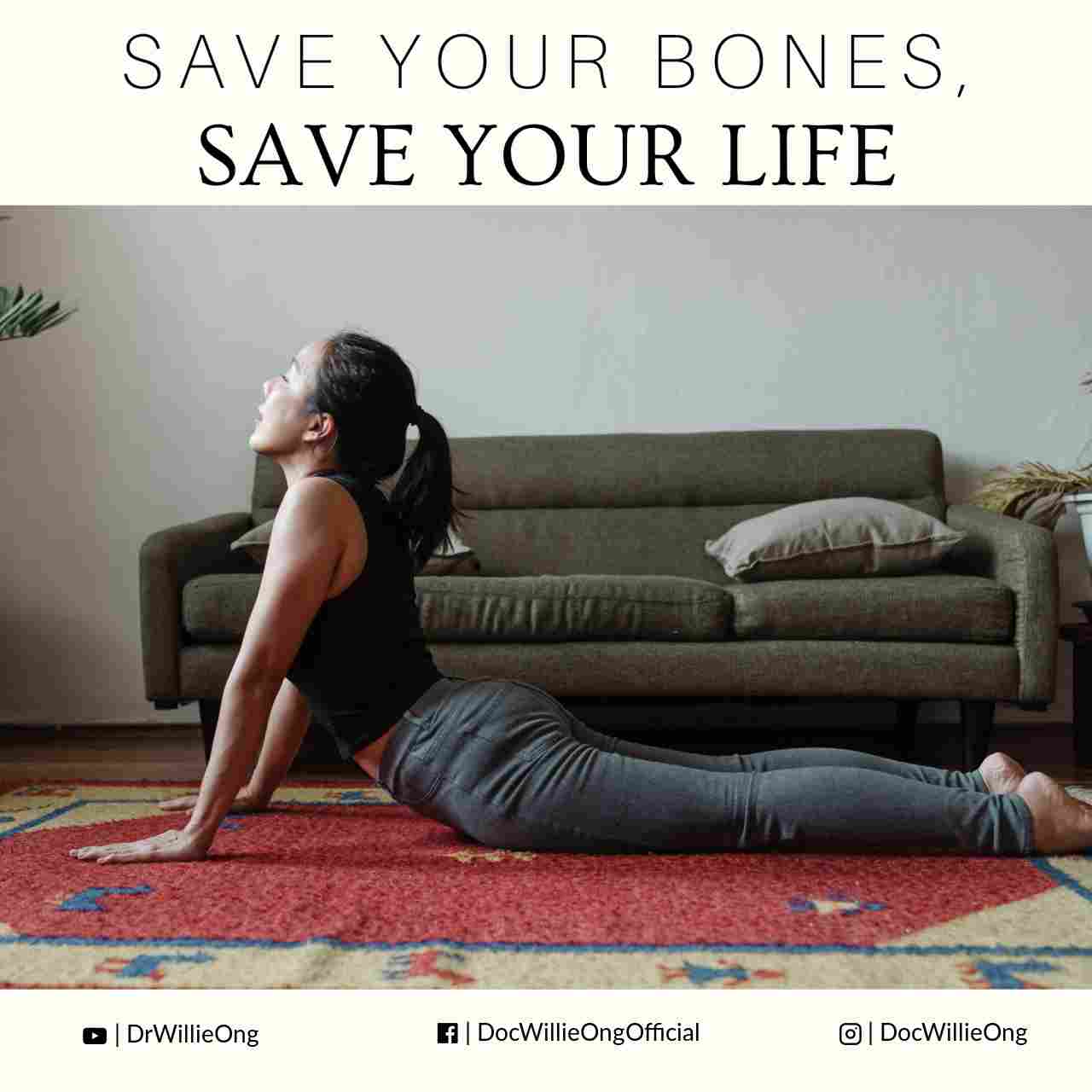By Dr. Willie Ong
Q. I’m a 52-year-old mom with 5 kids. One year ago, my doctor said I had osteopenia, now he says I have osteoporosis. What does this mean? What can I do to make my bones strong? (Dely)
A. Hi Dely, you have several risk factors for having weak bones: you’re a lady, you’re also in the menopausal stage. And you have 5 kids which can also decrease your calcium (the calcium goes to your children).
Osteopenia is a medical term, which means that your bone mass is below normal. Everyone develops some degree of osteopenia with age. With osteopenia, you have two times the risk for fracture.
Osteoporosis means weaker bones, which are prone to breaking. Your risk for fracture is increased up to 4 times. But don’t worry, we’ll list down all the possible ways to help you protect your bones.
How Is Bone Formed?
Did you know that our bones are alive? There could be bone tissue being added and some being removed at any given time. This process is known as “bone turnover” and is regulated by our hormones.
To have strong bones, you need to store calcium in your bones at a young age. The build-up stage occurs early in life and peaks at age 30. After this, there’s more bone breakdown than build up, hence our bones become thinner.
Who Are At Risk for Osteoporosis?
Osteoporosis is a silent disease without any symptoms. A fracture may be the first sign. Thus, we should be aware of the risk factors for developing it. These are:
- Older age
- Female sex – Up to 40 percent of post-menopausal women have it because they are hormonally more susceptible. Estrogen found in younger women is protective.
- Menopause or those who have undergone hysterectomy
- Family history of osteoporosis – It runs in families.
- Lack of exercise
- Lack of calcium in diet
- High protein diet
- Too much coffee
- Alcohol intake of more than 2 shots or 2 drinks per day
- Smoking
- Intake of steroids, chronic diseases and thyroid problems.
How Will I Know If My Bones Are Healthy?
- DEXA Test – This bone density test is mandated by the World Health Organization. It measures density at the hip, spine, and wrist.
- PDXA – Bone density at a specific site is tested. A scan is taken of your wrist, finger, or heel
- X-ray – Evaluates fractures and other bone problems, but not really a screening tool for osteoporosis.
8 Sure Ways To Protect Your Bones
Take high calcium foods
Calcium is necessary for bone formation. Milk, cheese, yogurt, dilis, anchovies, fish with bones are high in calcium. If you can’t drink milk, you may opt to eat lots of dark green leafy vegetables which also contain calcium. Soya milk is fine, too.
Young children need about 525 mg of calcium per day, adults about 800 mg, and breast feeding and pregnant women need about 1,200 mg per day.
Avoid high-protein and high sodium diet
A little-known fact: Eating a 10-ounce steak or any meat will interfere with your calcium absorption. Be sure to temper your diet with carbohydrates and fats, too.
Limit coffee
Sorry Starbucks, but too much coffee causes one to lose calcium in the urine. If you are at risk for osteoporosis, limit yourself to a light cup of coffee.
Avoid alcohol and smoking
Alcohol and tobacco interfere with bone formation. Did you know that alcohol has a detrimental effect on those cells responsible for bone formation? They make your “bone cells” lazy and sluggish to do their job. Ergo, you get weak bones. And if you’re drunk and fall over, you might crack your bones. Limit yourself to one or two alcoholic drinks. Better still, don’t drink at all.
Say “no” to soft drinks
Soft drinks, especially dark colas, contain phosphorous which can draw the calcium out of your bones. If you can’t help but drink soft drinks, then you need to take more calcium supplements to replace the one’s you will lose.
Exercise moderately
Any kind and any amount of exercise will help. But light weight-bearing exercises are best, such as using light dumbbells and brisk walking. Running, dancing and aerobics are great ways to strengthen your bones, that is if you can take it. Ask your doctor if your bones are strong enough for these high-impact exercises.
And did you know that household chores are great substitutes for exercise? Sweeping, cleaning, washing, and walking up and downs stairs all help to keep your bones strong and the house clean.
Take calcium supplements with vitamin D
The FDA recommends a daily intake of 1,000 mg of calcium for women. You can either take calcium citrate or calcium carbonate. Calcium citrate with vitamin D (like Caltrate Plus) is recommended for women who also take iron supplements. Calcium carbonate is cheaper and a good alternative.
For men, we should probably stick to a high calcium diet and use a lower dose of calcium, maybe around 500 mg or less. Why so? Some reports suggest that a high dose of calcium may cause a slightly increased risk of prostate cancer. Also, taking calcium supplements may also increase the risk of developing kidney stones. So remember to drink lots of water, at least 8 to 12 glasses a day, so we can flush the excess calcium out of our kidneys.
Ask your doctor about drugs options
a. Estrogen – Despite having some bad publicity in recent years, estrogen supplements are effective in preventing (but not treating) osteoporosis. Experts agree that estrogen can safely be given for 5 years from the start of menopause. Side effects of estrogen include a slight risk of blood clots, stroke and breast cancer. Recently, estrogen is having a comeback with some new studies showing it can benefit younger women. Stay tuned.
b. Selective estrogen receptor modulator (SERM) – For those women who have had breast cancer, these tissue-specific estrogens can be used. Locally, we have Evista (generic name Raloxifene). They have the same side effects as estrogen, and are given for osteoporosis prevention rather than treatment.
c. Biphosphonates – So far, the most effective treatment for osteoporosis are the bisphosphonates, marketed as Fosamax (generic name Alendronate Sodium), Actonel (Risedronate Sodium) and Bonviva (Ibandronic Acid).
Some good news: Studies show that bisphosphonates can decrease bone breakdown, reduce spine fracture risk by 30 to 50 percent, and lessen hip fracture risk by 24 to 50 percent.
Fosamax and Actonel are taken once a week while Bonviva is taking once a month. But (there’s always a but) these drugs are quite expensive and need your doctor’s supervision. Certain precautions need to be taken because these drugs are irritating on the esophagus and stomach.
Consult your doctor. If you have osteoporosis, your doctor can help you make a decision on which drug option is best for you.
In summary, the stronger the bone, the less likely it will fracture. Building bones strength should be started at an early age, so we can reap the benefits in our senior years. Your bones will improve with proper diet, exercise, and some medications as necessary. Plan for your bone health today.



